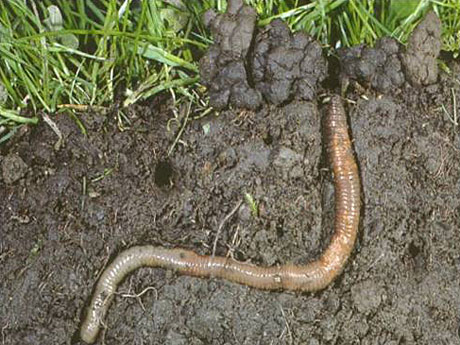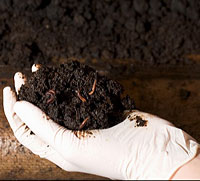
Photo credit: USDA NRCS
The basis of organic land care is promoting healthy soil which translates into healthy plants. The objectives of promoting healthy soil include:
- increasing organic matter through the use of compost
- correcting soil pH to maximize soil biological activity and nutrient uptake by plants
- promoting beneficial soil organisms which help make nutrients available to plants
Soil is made up of 4 major components:
- Air
- Water
- Minerals and rock fragments known as inorganic or non-living material
- Partially decaying plant and animal material known as organic matter
"We might regard the soil as the furnace of life, wherein organic matter is the fuel, soil organisms are the fire consuming the fuel, and the plant nutrients are the ashes of the combustion." Robert Barnes, Fertile Soil

The soil contains living organisms which make up the life of the soil. These organisms range from worms and insects to the tiniest of bacteria. The number of bacteria alone in 1 gram of soil may range from 100,000 to several billion!
It is the activity of these soil organisms, termed biological activity, that releases nutrients and makes them available for plant uptake. The biological activity starts with insects and earthworms shredding plant material and ends with the complete decomposition of the residues by the smallest of organisms such as bacteria and fungi. This decomposition process releases several nutrients including nitrogen, phosphorus, and sulfur, making them available for plant growth.
Soil organisms perform other important functions including:
- Taking nitrogen from the air and making it available to plants
- Form symbiotic relationships with plant roots, and helping the plant absorb nutrients
- Produce vitamins, growth hormones, and acids that help break down the mineral portion of the soil
- Bind organic matter and minerals, and mix it into the soil
- Create tunnels and nutrient rich fecal matter
- Prey on plant pathogens
To achieve optimal biological activity, soils need to be warm and have adequate moisture, drainage, and a pH above 6.
The first step for transitioning to organic should be to have the soil tested. No soil inputs should be made without a soil test which will contain information about soil nutrients, pH, composition, and the amount of organic matter. Your local Cooperative Extension office can tell you if they carry soil test kits. You can also download instructions for testing your soil from the Rutgers Soil Testing Laboratory website.

